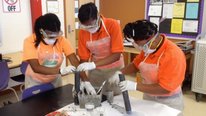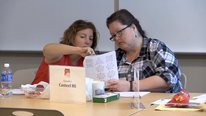JAMES MADDEN
Louisiana Math and Science Teacher Institute
NSF Awards: 0928847
This video describes how the Louisiana Math and Science Teacher Institute (LaMSTI) partners with school districts around Baton Rouge to help districts achieve their goals in providing quality learning opportunities in STEM.
LaMSTI is a professional master’s degree program at Louisiana State University (Baton Rouge) in which secondary math and science teachers learn, communicate and improve the knowledge base essential to teaching mathematics and science. The goal of LaMSTI is to create a well-integrated, effective professional degree program and around it a professional community spanning the university and K-12.
One hundred twenty teachers have been directly supported by LaMSTI. Of these, 96 have earned 30 hours of graduate credit in the program, and 81 have earned the LSU Master of Natural Sciences degree. An additional 55 STEM teachers supported by other grants benefited directly from participation in LaMSTI programs, and 51 of these earned the MNS degree The average number of students taught yearly by these teachers is between 60 and 130. Therefore, the number of K-12 student-course-years impacted annually by LaMSTI is around 17,000.
Louisiana Math and Science Teacher Institute
NSF Awards: 0928847
This video describes how the Louisiana Math and Science Teacher Institute (LaMSTI) partners with school districts around Baton Rouge to help districts achieve their goals in providing quality learning opportunities in STEM.
LaMSTI is a professional master’s degree program at Louisiana State University (Baton Rouge) in which secondary math and science teachers learn, communicate and improve the knowledge base essential to teaching mathematics and science. The goal of LaMSTI is to create a well-integrated, effective professional degree program and around it a professional community spanning the university and K-12.
One hundred twenty teachers have been directly supported by LaMSTI. Of these, 96 have earned 30 hours of graduate credit in the program, and 81 have earned the LSU Master of Natural Sciences degree. An additional 55 STEM teachers supported by other grants benefited directly from participation in LaMSTI programs, and 51 of these earned the MNS degree The average number of students taught yearly by these teachers is between 60 and 130. Therefore, the number of K-12 student-course-years impacted annually by LaMSTI is around 17,000.
-
 Cincinnati Engineering Enhanced Math and Science Program
Cincinnati Engineering Enhanced Math and Science Program
Julie Steimle
-
 Combating Chicago’s Computing Deserts
Combating Chicago’s Computing Deserts
Ugochi Acholonu
-
 MMRE
MMRE
Brittany Wnek
-
 Arizona Mathematics Partnership: AMPing Things Up!
Arizona Mathematics Partnership: AMPing Things Up!
April Strom
-
 Arts & Bots: Robots in Non-Traditional Classes
Arts & Bots: Robots in Non-Traditional Classes
Brett Slezak
-
 Introduction to Data Science: Thinking Critically About Data
Introduction to Data Science: Thinking Critically About Data
LeeAnn Trusela
5060 Views
Continue the discussion of this presentation on the Multiplex. Go to Multiplex
5060 Views
Related videos you might be interested in...
-
 Cincinnati Engineering Enhanced Math and Science Program
Cincinnati Engineering Enhanced Math and Science Program
Julie Steimle
-
 Combating Chicago’s Computing Deserts
Combating Chicago’s Computing Deserts
Ugochi Acholonu
-
 MMRE
MMRE
Brittany Wnek
-
 Arizona Mathematics Partnership: AMPing Things Up!
Arizona Mathematics Partnership: AMPing Things Up!
April Strom
-
 Arts & Bots: Robots in Non-Traditional Classes
Arts & Bots: Robots in Non-Traditional Classes
Brett Slezak
-
 Introduction to Data Science: Thinking Critically About Data
Introduction to Data Science: Thinking Critically About Data
LeeAnn Trusela

Gerald Kulm
Senior Professor
Hi. Thanks for sharing some information about this long-term project. What advice would you have for teacher educator to obtain the necessary long-term buy-in from school administrators? What incentives do teachers have, beyond the degree and possible self-satisfaction of seeing their teaching improve?
James Madden
Professor of Mathematics
These are very difficult problems.
The K-12 educational system (as far as my experience extends) is structured such that top district administration is accountable to: a) state and federal authorities, b) the community (mostly via school boards), c) the district employees and d) the students and their families. So, “buy-in” is … what? Why should an administrator seek to maintain a relationship to a university program? Only if it helps to meet the real accountability demands.
It may be that an administrator has a personal belief in the value of the partnership, but obviously this is not strong foundation. Another possibility is that the university program offers some utility to the district in meeting the actual accountability demands. Our program was useful to districts in terms of teacher recruitment and retention, so there was some some value here, this is much narrower than we had hoped for in creating the LaMSTI program.
During the project (2009—2015), the LSU Cain Center (the unit administering the LaMSTI program) began offering a variety services to districts: dual enrollment opportunities, courses to prepare students for dual enrollment, and focused teacher-training opportunities to equip teachers to deliver courses of both kinds. All of these services are gathered together in the “LSU College Readiness Program.” This program offers real value to districts because is helps them meet state and federal benchmarks, appeals to the community and offers attractive opportunities for teachers and students. With the College Readiness program, “buy-in” is replaced by a more robust interdependence.
Let me continue my response in a separate post…
James Madden
Professor of Mathematics
The College Readiness Program offers high-value services to districts and at the same time creates a revenue stream to the university through dual enrollment tuition. Much of this revenue is returned to the Cain Center, where is is used to support the the teacher-development programs that make the dual-enrollment courses possible.
This brings us to the answer to your second question: what is the incentive to teachers? Through the College Readiness Program, they obtain opportunities for more attractive teaching assignments, opportunities to work as mentors and professional developers—-real career enhancements.
James Madden
Professor of Mathematics
To wrap up this response, let me say that when the LaMSTI project was conceived, the College Readiness Program did not yet exist. When I wrote the LaMSTI proposal, I had very naive ideas about partnership—-basically that “buy-in” could be created on the basis of shared ideals. My experience shows that this is not enough. We need a foundation in an exchange of things with concrete, evident value. This is what the College Readiness Program provides.
Brian Drayton
It is impressive that you have districts willing to commit and support their teachers in their learning— as you say, the result of hard work on partnership development that builds from a shared understanding of needs and solutions. Has administrator turnover been a problem? Do teachers get rewarded for achieving advanced degrees? And do the districts or schools have to make some accommodations for the teachers participating in LaMSTI, or do they do most of the work on their own time?
James Madden
Professor of Mathematics
Changes in administration are not a problem, per se. Interest and willingness of administrators is essential, so changes can be good or bad.
Advanced degrees create career opportunities for teachers, e.g., qualification to teach dual enrollment. The Cain Center has worked to create opportunities for master teachers and teacher leaders, and some districts are doing this on their own, too.
The LaMSTI program (all 800 hours of it) accommodates teachers’ schedules. It is 80% in the summer. There is no overlap with teachers’ work routines.
Michelle Perry
Researcher
Thanks for sharing your video. Do you think you’ve sufficiently achieved the fifth goal of creating a sustainable program? What challenges, if any, have you encountered with the program and how were they addressed?
James Madden
Professor of Mathematics
Yes. What we are presently offering, in conjunction with the College Readiness Program, is fully self-sustaining.
Shabnam Etemadi
Thank you for sharing! What a great hands-on program to help both students and students-in-training to becoming teachers. Have you thought about linking the program to a college initiatives for the younger students?
Further posting is closed as the showcase has ended.